Related Research Articles

Albert Goodwill Spalding was an American pitcher, manager, and executive in the early years of professional baseball, and the co-founder of A.G. Spalding sporting goods company. He was born and raised in Byron, Illinois yet graduated from Rockford Central High School in Rockford, Illinois. He played major league baseball between 1871 and 1878. Spalding set a trend when he started wearing a baseball glove.
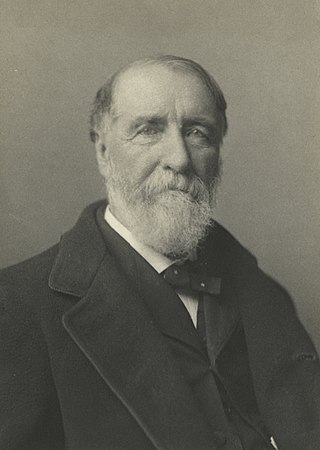
Henry Chadwick was an English-American sportswriter, baseball statistician and historian, often called the "Father of Baseball" for his early reporting on and contributions to the development of the game. He edited the first baseball guide that was sold to the public. He is credited with creating box scores, as well as creating the abbreviation "K" that designates a strikeout. He is said to have created the statistics of batting average and earned run average (ERA). He was posthumously inducted into the National Baseball Hall of Fame in 1938.
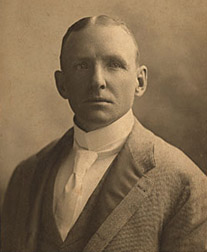
Adrian Constantine Anson, nicknamed "Cap" and "Pop", was an American Major League Baseball (MLB) first baseman. Including his time in the National Association (NA), he played a record 27 consecutive seasons. Anson was regarded as one of the greatest players of his era and one of the first superstars of the game. He spent most of his career with the Chicago Cubs franchise, serving as the club's manager, first baseman and, later in his tenure, minority owner. He led the team to six National League pennants in the 1880s. Anson was one of baseball's first great hitters, and probably the first to tally over 3,000 career hits. In addition to being a star player, he innovated managerial tactics such as signals between players and the rotation of pitchers.
The Sporting News is a website and former magazine publication owned by Sporting News Holdings, which is a U.S.-based sports media company formed in December 2020 by a private investor consortium. It was originally established in 1886 as a print magazine. It became the dominant American publication covering baseball, acquiring the nickname "The Bible of Baseball."

James Edward Sullivan was an American sports official of Irish descent. He was one of the founders of the Amateur Athletic Union (AAU) on Jan 21, 1888, serving as its secretary from 1889 until 1906 when he was elected as President of the Amateur Athletic Union from 1906 to 1909. He declined a fourth term and was re-elected to his former position as secretary-treasurer until his sudden death which followed an emergency operation. Sullivan also served as the chairman of the Greater New York Irish Athletic Association in 1903 and on the New York City Board of Education from 1908 to 1912. In 1911 he served as chairman of the New York State Athletic Commission.
The history of baseball can be broken down into various aspects: by era, by locale, by organizational-type, game evolution, as well as by political and cultural influence. The game evolved from older bat-and-ball games already being played in England by the mid-18th century. This game was brought by immigrants to North America, where the modern version developed. By the late 19th century, baseball was widely recognized as the national sport of the United States. Baseball is popular in North America and parts of Central and South America, the Caribbean, and East Asia, particularly in Japan, South Korea, and Taiwan.
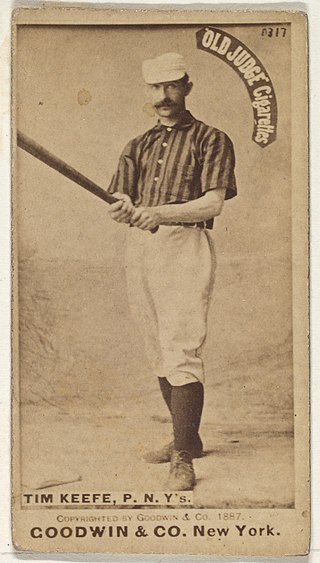
Timothy John Keefe, nicknamed "Smiling Tim" and "Sir Timothy", was an American Major League Baseball pitcher. He stood 5 feet 10 inches (1.78 m) tall and weighed 185 pounds (84 kg). He was one of the most dominating pitchers of the 19th century and posted impressive statistics in one category or another for almost every season he pitched. He was the second MLB pitcher to record 300 wins. He was elected to the Baseball Hall of Fame in 1964.

Charles Arthur "Dazzy" Vance was an American professional baseball player. He played as a pitcher for five different franchises in Major League Baseball (MLB) in a career that spanned twenty years. Known for his impressive fastball, Vance was the only pitcher to lead the National League in strikeouts seven consecutive seasons. Vance was inducted into the Baseball Hall of Fame in 1955.
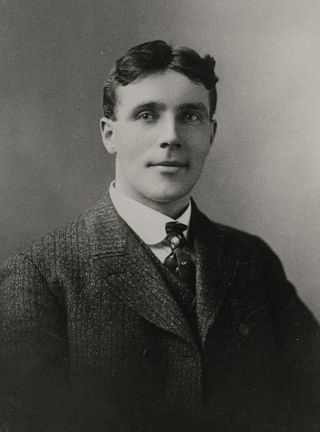
James Edward "Tip" O'Neill was a Canadian professional baseball player from approximately 1875 to 1892. He began playing organized baseball in Woodstock, Ontario, Canada, and later played ten seasons in Major League Baseball, principally as a left fielder, but also as a pitcher, for four major league clubs.

Spalding is an American sports equipment manufacturing company founded by Albert Spalding in Chicago, in 1876, although it is now headquartered in Bowling Green, Kentucky. Spalding currently primarily focuses on basketball, mainly producing balls but also commercializing hoops, rims, nets and ball pump needles. Softballs are commercialized through its subsidiary Dudley Sports.

Martin Francis Hogan, nicknamed "The Indianapolis Ringer", was an English born right fielder in Major League Baseball who played for the Cincinnati Reds (1894) and St. Louis Browns (1894–1895). After leaving the National League, Hogan moved on to the minor league Indianapolis Hoosiers. Some sources suggest he set a national baserunning record in the 1890s.

The Youngstown Ohio Works baseball team was a minor league club that was known for winning the premier championship of the Ohio–Pennsylvania League in 1905, and for launching the professional career of pitcher Roy Castleton a year later. A training ground for several players and officials who later established careers in Major League Baseball, the team proved a formidable regional competitor and also won the 1906 league championship.
Baseball is a growing, minor sport in the United Kingdom, with an estimated 22,500 people playing in 2020.

Harry Simmons was an American professional baseball executive, writer and historian. He worked in Minor League Baseball for the International League from 1946 until 1966, first in New York City then in Montreal. He then worked in Major League Baseball for the Office of the Commissioner of Baseball until his retirement in 1982. Simmons was nicknamed "Mr. Baseball" and is an inductee of the Canadian Baseball Hall of Fame.
This is a summary of the evolution of names of the current professional Major League Baseball teams in the National League and subsequent rival American League, and also of selected former major and minor league teams whose names were influential, long-lasting, or both. The sources of the names included club names, team colors, and city symbols. The names have sometimes been dubbed by the media, other times through conscious advertising marketing by the team, or sometimes a little of both.
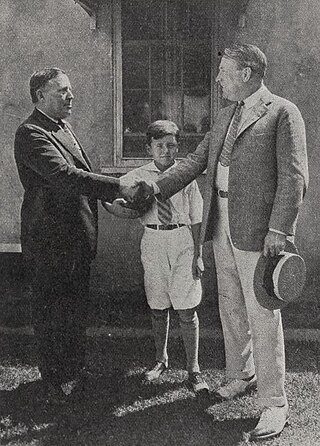
Thomas W. Cahill was one of the founding fathers of soccer in the United States, and is considered the most important administrator in U.S. Soccer before World War II. Cahill formed the United States Football Association in 1913, which later became the United States Soccer Federation. In 1916 he became the first coach of the United States men's national soccer team. Cahill was enshrined in the U.S. National Soccer Hall of Fame in 1950.
The Youngstown Indians were a Minor League Baseball club that competed during the 1909 season in the Ohio–Pennsylvania League. The team showed great promise at the outset of the season but finished with a disappointing 46–78 record, placing last in the league. The league championship that year went to an Akron franchise, which closed the season with an 81–40 record.

The Doubleday myth is the claim that the sport of baseball was invented in 1839 by future American Civil War general Abner Doubleday in Cooperstown, New York. In response to a dispute over whether baseball originated in the United States or was a variation of the British game rounders, the Mills Commission was formed in 1905 to seek out evidence. Mining engineer Abner Graves authored a letter claiming that Doubleday invented baseball. The letter was published in a newspaper and eventually used by the Mills Commission to support its finding that the game was of American origin. In 1908, it named Doubleday the creator of baseball.

John Buckingham Foster was an American baseball writer, ballclub officer and sports editor.
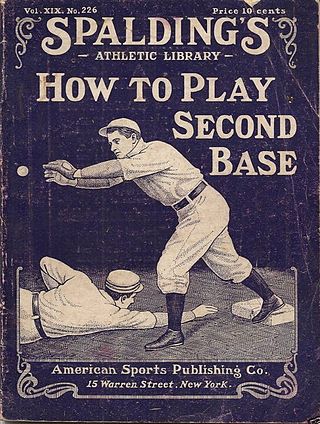
Spalding Athletic Library sold sports and exercise books through American Sports Publishing Company from 1892 to 1941. Both companies were owned and founded by Spalding. Books cover over 30 different sports and exercises, and over 20 different organizations.
References
- ↑ The Beadle Collection of Dime Novels: Given to the New York Public Library by Dr. Frank P. O'Brien. New York Public Library. 1922. p. 14.